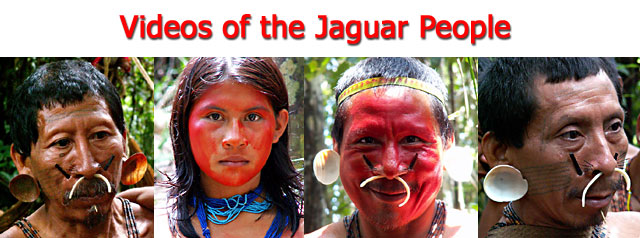
Uncontacted Amazon Indians in PeruBy Dr. Dan James Pantone |
|
|
|
|
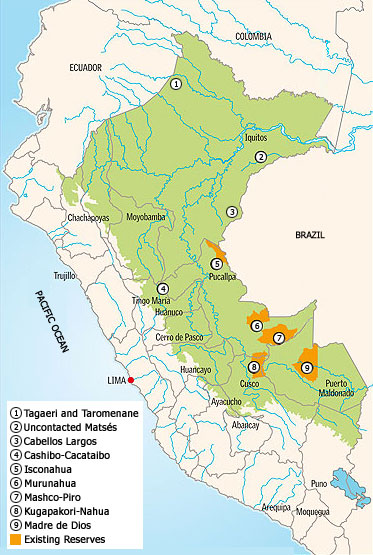
|
|
n Peru, it is estimated
that there are at least 15 uncontacted tribes living in remote areas of the
Peruvian Amazon Rainforest. These include the Tagaeri, Taromenane,
uncontacted Matsés, Cabellos Largos, Cashibo-Cacataibo, Isconahua,
Murunahua (Chitonahua), Mashco-Piro, Kugapakori, Nahua, Matsigenka (Machiguenga
or Machigenga),
Mastanahua, Nanti and Yora tribes. Of an estimated 100 uncontacted tribes
worldwide, about half of these people living in isolation from the rest of the world are
thought to live in Peru and neighboring Brazil. After Brazil, Peru has the
largest number of uncontacted tribes and people living in isolation in the
world. Using the above map of
uncontacted Amazonian tribes in Peru as a reference, there are nine principal
areas in Peru where indigenous people are thought to be living in isolation. Most of these uncontacted
indigenous Amazonians are believed to live in the remote border region of Peru with
Brazil. So what do we know about these indigenous Peruvians living in
isolation and what does the future hold for them? On the border of Ecuador with Peru, the Tagaeri and Taromenane tribes are known to exist. Thought to be closely related to the Huaorani (Waorani) tribe, the Ecuadorian government has set aside a reserve area for them known as the Zona Intangible between the Shiripuno and Curaray Rivers. On the Peruvian side of the border, no reserve exists for these uncontacted indigenous people. Worse, oil companies have received oil concessions from the Peruvian government and have recently begun drilling for oil in the area. Activities by petroleum companies on the Peruvian side of the border could cause problems on the Ecuadorian side. This exploration and drilling for oil could push the uncontacted Tagaeri and Taromenane tribes closer to the Huaorani villages in Ecuador. Currently, the Huaorani people in Ecuador are fighting to protect their rights and also the rights of the Tagaeris and Taromenanes, who obviously cannot defend themselves politically. However, the pushing of these uncontacted tribes by oil companies from Peru into Ecuador could mean surprise and violent encounters between these isolated peoples and the Huaoranis in Ecuador. Uncontacted Matsés Similar to there being uncontacted tribes related to the Huaorani (i.e. Tagaeri and Tarmenane tribes), there are thought to be tribes closely related to the Matsés living in the Yavarí Mirím area on the border of Peru with Brazil. The federation of Peruvian tribes (AIDESEP, Asociación Interétnica de Desarrollo de la Selva Peruana) has formally requested that the Peruvian government set aside the area north of the Yavarí Mirím River, as a refuge for this population of uncontacted Amazonians. No one really knows much about them. The Field Museum of Chicago who recently made of biological survey of the area has stated that there may be uncontacted members of the Matsés tribe still living in isolation. Others say that members of the Korubo tribe frequent this area. The Korubos are another Pano-speaking tribe related to the Matsés who are know to live across the border in Brazil, with the majority still living in isolation with no contact with the outside world. In any case, it would be prudent for the Peruvian government to protect these people and their territory before they and their forest are destroyed. Unfortunately Alan Garcia, the current president of Peru, has ignored the request by AIDESEP to protect uncontacted people in the Yavarí Mirím area and has taken a hard line against all uncontacted Peruvian natives stating that there is no real evidence that they exist in Peru. Moreover, Garcia has encouraged the destruction of this pristine Amazon rainforest by approving new logging concessions in the Yavarí Mirím ignoring the advice of AIDESEP and the Field Museum to create a reserve. Cabellos Largos Perhaps the most striking evidence of the existence of uncontacted natives on the Peruvian-Brazilian border area was the release of photographs by the Brazilian government of natives with long hair, the Cabellos Largos. This confirms recent reports by members of the Matsés tribe of encounters with long-haired uncontacted natives to the south of the Matsés territories in the area marked with the number 3 in the above map of uncontacted Amazon tribes in Peru. Now there is no denying that the Matsés were correct and this is irrefutable physical evidence of the existence of uncontacted indigenous people in the border area of Peru and Brazil. The indigenous rights organization AIDESEP and other non-governmental organizations have petitioned the Peruvian government to create the Yavarí-Tapiche Reserve in this area that would protect uncontacted natives as well as expand Matsés control over their traditional hunting territory. Sadly, the Garcia administration has instead designated this area as Petroleum Block 135 and has recently given permission to Pacific Rubiales Energy (formerly Pacific Stratus Energy), a Colombian-Canadian oil company, to explore and drill for oil in this region. Cashibo-Cacataibo Uncontacted natives, related to the Cashibo-Cacataibo tribe, are thought to live in the area north of Tingo Maria in the foothills of the Andes Mountains. The Cashibo-Cacataibos speak a language in the Pano linguistic family and the word Cashibo means "bat" (referring to the animal). A group of the Cashibo-Cacataibos have chosen to live apart from the outside world by voluntarily isolating themselves. They live in the headwaters of the Aguaytía, Pisqui, and San Alejandro Rivers in and around the Cordillera Azul National Park. These indigenous Amazonians are sometimes referred to as the "Cacataibos in isolation" or the "Camanos." Cashibo-Cacataibo natives in isolation know about the outside world and have chosen to live apart from it voluntarily. However, they no longer have contact with outsiders and therefore, can be properly classified as "uncontacted." This may be the case with many, if not all, uncontacted peoples. They are not ignorant of the world around them; they just have chosen to live apart from it. Knowing the history of what generally happens when first contact takes place with the outside world, in that commonly 50 percent of the population dies due to diseases or violence, one would conclude that this is very astute behavior on their part. Isconahua
Murunahua The story of the Murunahua
people is similar to that of other uncontacted people. In 1996, loggers that were
illegally harvesting timber came into contact with the Murunahua Indians
(sometimes called the Chitonahuas). In the years following first contact,
about half of them died from diseases and violence. At the request of
AIDESEP in 1997, the Peruvian government created the Murunahua Territorial
Reserve measuring 482,000 hectares located en the Province of Atalaya and
Departament of Ucayali. The reserve was meant to protect both recently
contacted Murunahuas and those Murunahuas voluntarily living in isolation.
However, Peru's INRENA (Instituto Nacional de Recursos Naturales) has reported
that loggers are destroying the Murunahua's rainforest by illegally cutting
timber inside of the reserve. Specifically, loggers have constructed a
road through the Murunahua Territorial Reserve to Puerto Italia on the Ucayali
River in order to transport illegally harvested mahogany and other valuable
tropical hardwoods. This road was constructed illegally by Forestal Venao,
a Peruvian logging company, in that no environmental impact study was made.
Timber harvesting inside the Yurua area of the Murunahua Reserve has caused
international outrage in that the Brazilian government's Instituto Brasilero de
Medio Ambiente (IBAMA) has complained that Forestal Venao is causing
environmental damage to the forest and indigenous communities located on the
Brazilian side of the border. An estimated 60 per cent of the Murunahua
Territorial Reserve has been cut by loggers putting the very survival of the
Murunahua people in jeopardy. Spectacular photographs and video of a "lost tribe" thought to belong to the Mashco-Piro people were captured by an aerial reconnaissance team organized by INRENA in September of 2007. Flying along the Las Piedras River in the Alto Purús National Park, they were searching for illegal loggers when they sighted a group of 21 uncontacted naked natives on the banks of the river. In addition, they observed five recently constructed shelters made out of palm leaves. Making a second pass over these uncontacted indigenous people, they observed and photographed a women with arrows in her hands and a child at her side. The rest of the natives had fled into the forest. This group of uncontacted indigenous people are thought to belong to the Mascho-Piro tribe due to the manner in which they construct their shelters out of palm leaves. The Mascho-Piro tribe is known from an incident in 2001 in which 100 members of this uncontacted group attacked members of the Arahuacas and Sharanaguas, tribes who were living in contact with the western world. As one would expect, the presence of illegal loggers in the vicinity of this tribe living in voluntary isolation puts their survival at risk. Kugapakori-Nahua
Madre de Dios In Madre de Dios there is the Territorial Reserve for People in Voluntary Isolation. Created in 2002 at the request of AIDESEP specifically to protect those indigenous Amazonians that choose to live in isolation, this reserve has been under recent pressure from logging company interests to allow timber harvesting. Since the creation of the reserve, four violent encounters have been reported within the boundaries of the Territorial Reserve for People in Voluntary Isolation in Madre de Dios, with the resulting death of four loggers and an unknown number of indigenous natives living in isolation. Studies by scientists (Schulte-Herbrüggen and Rossiter, 2003) have counted 224 logging camps located within the territorial reserve with an estimated total number of 2286 loggers. To make matters worse for indigenous people living in voluntary isolation, the Peruvian government has included the reserve in Petroleum Block 113 which will allow oil companies to enter, exploring and drilling for oil inside the indigenous reserve. International and Peruvian Laws International law
(International Labour Convention 169, ratified by the Peruvian government) protects
uncontacted natives in Peru. It would wise for the Peruvian people to
demand that the Peruvian government comply with their international agreements
and protect these uncontacted Amazonian natives. In addition, the
Peruvian Congress has recently passed new laws to protect uncontacted natives in Peru.
In May of 2006, the Peruvian Congress approved Law 28736 to protect indigenous
tribes currently in isolation or recently contacted. Despite both international and
Peruvian laws that protect uncontacted tribes, current activities by loggers and
oil companies are putting in severe risk the survival of uncontacted indigenous
tribes in Peru.
|
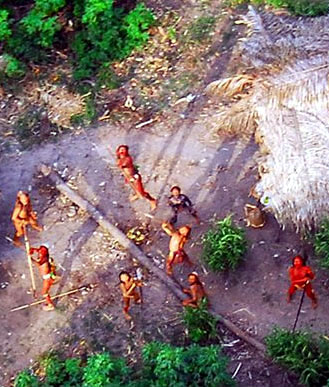
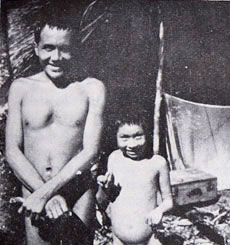 The
Isconahua tribe speaks a dialect of the Pano language family that is related to
Shipibo. Most of what we know about the Isconahuas dates back to 1959,
when missionaries from the South American Indian Mission encountered a
group of 25 Isconahuas living near the Brazilian border. The missionaries lived
with the Isconahuas for a year making ethnographic studies. They reported
that the women were completely nude, wearing only with brown "paniba" necklaces
and shells. Some of the women adorned their faces with mother-of-pearl
discs that hanged from an aperture in their nasal septum. The Isconahua
men only wore a "chajo jau," a small bone that was tied to their waists with a
thin cord to support their male member. More recently in 1995, a study by
AIDESEP reported that 80 Isconahuas were living in voluntary isolation near the
headwaters of the Utiquinia and Abujao rivers, hidden in the canyons of the
Callería River. In 1998 at the request of AIDESEP, the Peruvian government
created the Isconahua Territorial Reserve, consisting of 275,665 hectares.
However, attempts by anthropologists to reestablish contact with the Isconahuas
in 2004 and 2005 failed with the scientists concluding that the Isconahuas have
fled to the Brazilian side of the border in order to avoid contact with invading
loggers and miners who had been illegally entering their reserve. To make
matters worse, the Peruvian government's PeruPetro has included the Isconahua
reserve in Petroleum Block 138 and has sold this oil concession to Pacific
Rubiales Energy which gives this foreign oil company the right to explore and
drill for oil in their indigenous reserve.
The
Isconahua tribe speaks a dialect of the Pano language family that is related to
Shipibo. Most of what we know about the Isconahuas dates back to 1959,
when missionaries from the South American Indian Mission encountered a
group of 25 Isconahuas living near the Brazilian border. The missionaries lived
with the Isconahuas for a year making ethnographic studies. They reported
that the women were completely nude, wearing only with brown "paniba" necklaces
and shells. Some of the women adorned their faces with mother-of-pearl
discs that hanged from an aperture in their nasal septum. The Isconahua
men only wore a "chajo jau," a small bone that was tied to their waists with a
thin cord to support their male member. More recently in 1995, a study by
AIDESEP reported that 80 Isconahuas were living in voluntary isolation near the
headwaters of the Utiquinia and Abujao rivers, hidden in the canyons of the
Callería River. In 1998 at the request of AIDESEP, the Peruvian government
created the Isconahua Territorial Reserve, consisting of 275,665 hectares.
However, attempts by anthropologists to reestablish contact with the Isconahuas
in 2004 and 2005 failed with the scientists concluding that the Isconahuas have
fled to the Brazilian side of the border in order to avoid contact with invading
loggers and miners who had been illegally entering their reserve. To make
matters worse, the Peruvian government's PeruPetro has included the Isconahua
reserve in Petroleum Block 138 and has sold this oil concession to Pacific
Rubiales Energy which gives this foreign oil company the right to explore and
drill for oil in their indigenous reserve. 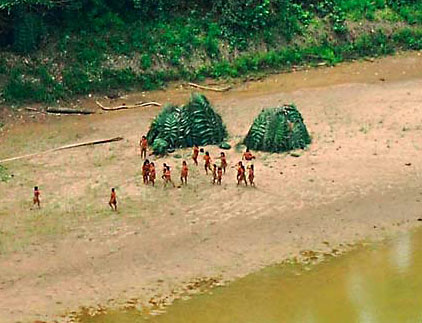 Mascho-Piro
Mascho-Piro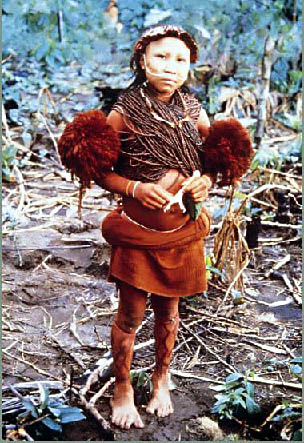 In
the early 1980s, petroleum exploration by the British-Dutch Shell Oil Company
led to the first contact with the previously uncontacted Nahua tribe.
Tragically, within several years more than half of the Nahua tribe had died.
The Nahua people (also called the Yura, Yurahahua, or Yora) are estimated to
have a population of about 450 people and includes both contacted and
uncontacted groups. They speak a language in the Pano linguistic family.
Just as has occurred in the past, future oil exploration authorized by PeruPetro
in the Kugapakori-Nahua Reserve will most certainly lead to more violent and
disastrous encounters with the Nahuas and other Amazon Indians who have chosen
to live in isolation. The Camisea natural gas pipeline project has become
particularly controversial in that it involved constructing pipelines on the Kugapakori-Nahua
Reserve and was financed with public funds from the Inter-American
Development Bank. In addition, frequent leaks from the Camisea pipeline
have become an ecological nightmare, severely polluting the fragile ecosystem of
the Amazon Rainforest upon which these uncontacted indigenous people base their
survival.
In
the early 1980s, petroleum exploration by the British-Dutch Shell Oil Company
led to the first contact with the previously uncontacted Nahua tribe.
Tragically, within several years more than half of the Nahua tribe had died.
The Nahua people (also called the Yura, Yurahahua, or Yora) are estimated to
have a population of about 450 people and includes both contacted and
uncontacted groups. They speak a language in the Pano linguistic family.
Just as has occurred in the past, future oil exploration authorized by PeruPetro
in the Kugapakori-Nahua Reserve will most certainly lead to more violent and
disastrous encounters with the Nahuas and other Amazon Indians who have chosen
to live in isolation. The Camisea natural gas pipeline project has become
particularly controversial in that it involved constructing pipelines on the Kugapakori-Nahua
Reserve and was financed with public funds from the Inter-American
Development Bank. In addition, frequent leaks from the Camisea pipeline
have become an ecological nightmare, severely polluting the fragile ecosystem of
the Amazon Rainforest upon which these uncontacted indigenous people base their
survival. 